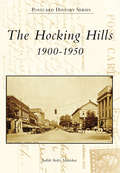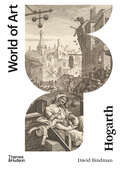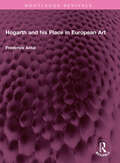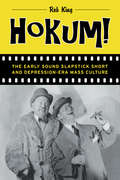- Table View
- List View
Hockey in Charlotte (Images of Sports)
by Jim Mancuso Pat KellyCharlotte is considered the birthplace of professional hockey in the South. The city of Charlotte, home of the Checkers (originally known as the Clippers), is the greatest Southern town in the history of professional hockey, winning the most play-off championships: three Eastern Hockey League titles, two Southern Hockey League titles, and one East Coast Hockey League title. Several Charlotte players and coaches starred in the National Hockey League--including Walter "Turk" Broda, John Brophy, Fred Creighton, Bill "Cowboy" Flett, Mike Hartman, Pat Kelly, Jackie Leclair, and John Muckler.
Hockey in Dayton (Images of Sports)
by Chuck GabringerIn the 1950s, crowds that equaled half the city of Troy's population filled the newly constructed 3,900-seat Hobart Arena to watch the area's first hockey team, the Troy Bruins, take the ice. In the 1960s and 1970s, fans packed one of hockey's great "barns," Hara Arena, to watch the Dayton Gems become one of the more well-known and successful franchises in all of professional hockey. In the 1990s and 2000s, it was the Dayton Bombers that reignited the area's love for hockey. Hockey in Dayton tells the story of the teams, players, people, and events that have permanently frozen hockey's place in the history of Dayton area sports.
Hockey in Providence (Images of Sports)
by Jim MancusoProvidence has an old and rich hockey tradition. The Providence Reds were one of the first professional hockey teams in the United States. In their 51-year history (1926-1977), the Reds won seven playoff championships, including four Calder Cup titles. The Reds were the first minor-league hockey team to operate for 50 seasons. The Providence Bruins, established in the 1992-1993 season, carry on the city's great hockey legacy and gave Providence its fifth Calder Cup title. Several Hockey Hall of Famers have played for Providence-based teams, including Bobby Bauer, Hector "Toe" Blake, Johnny Bower, Frank Brimsek, Eddie Giacomin, Rod Langway, Milt Schmidt, and Lorne "Gump" Worsley.
Hockey in Rochester: The Americans' Tradition (Images of Sports)
by Blaise M. LamphierRochester, New York, emerged courageously with its first professional hockey team in the fall of 1935: the Rochester Cardinals. However, the venture was short-lived due to the financial strain of the Great Depression. Finally, in 1956, thanks to local visionaries such as Sam Toth and Ed House, Rochester became home to the Americans. The "Amerks" began a legacy of greatness from their inception as a joint affiliate of the legendary Montreal Canadiens and Toronto Maple Leafs. This volume is a salute to those who have shaped Rochester's hockey history for more than thirty-seven hundred games.
Hockey in Springfield (Images of Sports)
by Jim MancusoSpringfield has a dynamic hockey history that dates back 80 years, beginning with the Springfield Indians. One of the first professional hockey teams in the United States, the Indians were an inaugural member of the Canadian-American Hockey League. The Indians helped form the American Hockey League, where Springfield won seven Calder Cups, including a record three in a row from 1960 through 1962. Major-league hockey followed in the mid-1970s, when the New England Whalers came to town. Today, the Springfield Falcons carry on the city's great hockey legacy. Several hall of famers have skated for Springfield-based teams over the years, including Gordie Howe, Brian Kilrea, Chuck Rayner, Earl Seibert, Eddie Shore, Billy Smith, and Lorne "Gump" Worsley. Hockey in Springfield is the story of the teams, players, and coaches who make up one of the richest hockey traditions in all of North America.
Hockey in Syracuse (Images of Sports)
by Jim MancusoHockey in Syracuse retraces the history of the eight professional teams that have taken the ice in Syracuse in six different leagues since 1930. Each team has its own colorful story, beginning with the Syracuse Stars of the International Hockey League. The "Twinklers" have the distinction of capturing the first Calder Cup ever awarded. Other teams included the Warriors (1951-1954), the Braves (1962-1963), the Blazers (1967-1977), the Eagles (1974-1975), the Firebirds (1979-1980), and the Hornets (1980-1981). The present-day Crunch brought hockey back in 1994 and have provided Syracuse fans with thrills on theice ever since. Salt City teams have won four playoffchampionships and have set several all-time professional hockey records that still stand today. Hockey Hall of Famers from these teams include Keith "Bingo" Allen, Gord Drillon, Phil Esposito, Syd Howe, and Dave "Sweeney" Schriner. Syracuse truly has a rich hockey heritage.
Hockey in the Capital District
by James MancusoHockey in the Capital District chronicles professional hockey in the capital region of New York State: Albany, Schenectady, and Troy. A total of six professional teams have taken the ice in four different leagues, beginning in the 1952-1953 season with the Troy Uncle Sam's Trojans. The tradition continued with the Schenectady Chiefs (1981-1982), the Troy Slapshots (1986-1987), the Albany Choppers (1990-1991), the Troy-based Capital District Islanders (1990-1993), and the Albany River Rats (1993-present). The River Rats brought the area its fi rst championship by capturing the AHL's Calder Cup. Through historic images, this volume presents the rich hockey heritage of the Capital District.
Hockey's Original 6: Great Players of the Golden Era
by Mike Leonetti&“Hockey historians will appreciate the precision action shots taken of the first cohort of NHL stars . . . a record of how hockey has evolved.&” —Winnipeg Free Press The hockey stars of the 1950s and &’60s—Rocket Richard, Gordie Howe, Dave Keon, Bobby Hull, Jean Beliveau, Terry Sawchuk, Tim Horton, and others—were some of the most passionate players in National Hockey League history. These skillful and often colorful athletes played exhilarating hockey and were national heroes in a time when only six teams and fewer than 150 players battled for the Stanley Cup. Hockey&’s Original 6 celebrates the most dynamic players and exciting moments of the era in more than 120 photographs from the legendary Harold Barkley Archives, including a number of never—or rarely seen—images. From 1942 until the early &’70s, Barkley was the Toronto Star&’s leading sports photographer. He pioneered the use of electronic flash to capture stop-action hockey, and his dramatic work—both black and white and vibrant color—define the pre-expansion period. Two informative essays by Mike Leonetti—hockey historian, archivist, and prolific sportswriter—set Barkley and the photos in context, and short image captions illuminate the players and their feats. The late hockey legend Jean Béliveau provides a personal and insightful foreword. &“Will take your breath away . . . a collection that captures players&’ grimaces, suture tracks, missing teeth and Brylcreem-lacquered hair; their primitive equipment, joy and considerable pain, even the depth of snow beneath their tubular-steel blades, the individual planks of lumber that were the arena boards, and the octagonal orange crests on the Tyer Rubber Co. pucks whose impact has smudged the fire-engine-red goalposts.&” —The Montreal Gazette
Hockey, PQ
by Amy RansomA wide-ranging study that examines everything from the blockbuster movie franchise Les Boys to the sovereigntist hip hop group Loco Locass, Hockey, PQ explores how Canada's national sport has been used to signify a specific Québécois identity. Amy J. Ransom analyzes how Québécois writers, filmmakers, and musicians have appropriated symbols like the Montreal Forum, Maurice Richard, or the 1972 Summit Series to construct or critique images of the Québécois male.Close analyses of hockey-themed narratives consider the soap opera Lance et compte ('He shoots, he scores'), the music of former pro player Bob Bisonnette, folk band Mes Aïeux, rock group Les Dales Hawerchuk, and the fiction of François Barcelo. Through these examinations of the role hockey plays in contemporary francophone popular culture, Ransom shows how Quebec's popular culture uses hockey to distinguish French-Canadians from the French and to rally them against their English-speaking counterparts. In the end, however, this study illuminates how the sport of hockey unites the two solitudes.
Hocking Hills, The: 1900-1950
by Judith Stoltz ManiskasThe Hocking Hills is a term given to the area in southeastern Ohio located predominately in Hocking County. Millions of tourists visit the valley each year to experience the primary feature of the Hocking Hills: the beautiful and historic cave system that stands today as it has for eons. From 1900 to 1950, the caves were a popular subject for postcard images, and town and country residents who lived and worked in this area were captured on vintage postcards. Residents created their own entertainment, and Main Street parades, the county fair, holidays, patriotic events, and family gatherings were celebrated and recorded with penny postcards.
Hoe zorg je voor je konijn: Inclusief het kiezen van de beste huisdierrassen
by Amber Richards Vincent OostelbosOf je nu konijnen houdt voor de toonzaal of om te genieten van het rustgevende comfort dat deze speelse beestjes brengen, je kunt bij dit boek terecht voor de essenties van zorg voor konijnen. Geschreven door een professionele konijnenfokker is Hoe zorg je voor je konijn een uitgebreide zorggids voor konijnenliefhebbers die de details willen weten over zorg voor een konijn, liever dan informatie over fokken. Houd je konijn gezond en tevreden; wij lopen je door het proces heen, stap voor stap. Leer hoe je een konijnenhok bouwt, zorgt voor nagels en tanden, je konijn voedt, een slaapplek prepareert, en nog veel meer! Dit is een gids voor huisdierbezitters, niet één die ingaat op commercieel fokken, dus gaat hij niet in op het onderwerp van het fokken van konijnen. Van het zenuwachtig bewegen van een neusje tot het zachte, zijdeachtige lijfje: je zult snel verliefd worden op je nieuwe konijnvormige bondgenoot. Ontdek een complete, uitputtende lijst van konijnenrassen die worden erkend door de American Rabbit Breeders Association. Je leert precies welke rassen geschikt zijn als huisdier voor je gezin, en welke te vermijden. Pik vandaag je kopie op van Hoe zorg je voor je konijn en ervaar de wonderlijke geneugten die een konijn als huisdier je zal brengen.
Hoedowns, Reels, and Frolics: Roots and Branches of Southern Appalachian Dance
by Phil JamisonIn Hoedowns, Reels, and Frolics, old-time musician and flatfoot dancer Philip Jamison journeys into the past and surveys the present to tell the story behind the square dances, step dances, reels, and other forms of dance practiced in southern Appalachia. These distinctive folk dances, Jamison argues, are not the unaltered jigs and reels brought by early British settlers, but hybrids that developed over time by adopting and incorporating elements from other popular forms. He traces the forms from their European, African American, and Native American roots to the modern day. On the way he explores the powerful influence of black culture, showing how practices such as calling dances as well as specific kinds of steps combined with white European forms to create distinctly "American" dances. From cakewalks to clogging, and from the Shoo-fly Swing to the Virginia Reel, Hoedowns, Reels, and Frolics reinterprets an essential aspect of Appalachian culture.
Hogan's Heroes
by Robert R. ShandleyAnalyzes the unique satirical social and political commentary offered by Hogan's Heroes during a volatile period in American history.
Hogan's Heroes: Behind the Scenes at Stalag 13!
by Brenda Scott RoyceAn insider’s look at the surprisingly successful, perennially popular classic 1960s sitcom set in a prisoner-of-war camp in World War II Germany.If your fondest TV memories involve the POWs of Stalag 13 cleverly outwitting their captors, Schultz stammering “I know nothing!” and Hochstetter threatening to send everyone to the Russian front, then this is the book for you. This fun and informative book takes you behind the scenes of the classic 1960s sitcom to reveal:the story behind the creation, production, and eventual cancellation of the seriesthe controversy surrounding the show’s unlikely premiseinterviews with many of the show’s stars and crewbiographies of the stars and supporting actorsa detailed guide to each of the 168 episodesa guide to collecting Hogan’s memorabilia and more . . . Hogan’s Heroes is more popular now than ever before, especially in Germany, where it has become a surprising cult hit. In this book, most of the show’s stars and behind-the-scenes personnel share their memories and reflect on the series’ enduring popularity.
Hogarth (World of Art)
by David BindmanA new, updated edition of this illuminating study on William Hogarth, one of the eighteenth century’s most famous artists and satirists. William Hogarth (1697–1764) was one of the great eighteenth-century painters, a marvelous colorist, and an innovator at all levels of artistic expression. In this updated volume, art historian and Hogarth scholar David Bindman surveys the works of this artist whose wry humor and sharp wit was reflected in his prolific paintings and prints, including The Rake’s Progress and Marriage A-la-Mode. Hogarth was also a master of pictorial satire, highlighting the moral and political issues of the day with delightful detail and comedy—themes that resonate deeply with our times. This new edition has been specially updated to include a discussion of Hogarth’s representation of Black people in eighteenth-century Britain, a subject that has long been overlooked in his many works. Now revised with additional material and illustrated in color throughout, this is a vivid and incisive study of the artist.
Hogarth and his Place in European Art (Routledge Revivals)
by Frederick AntalFirst published in 1962, Hogarth and his Place in European Art attempts to convey the historical relevance, both in its native and European context, of perhaps the most outstanding English painter of the eighteenth century. Dr. Antal applies his method of establishing the close relationship between the political and social history and the arts and letters of the period. Thus, the book goes far beyond the limits of art historical appreciation. It gives a panoramic picture of the first half of the eighteenth century in England with all its social, literary, and artistic connotations. He shows how England, which during those years became both politically and economically the most advanced country in Europe, could provide in Hogarth, in spite of the slender native tradition, the most progressive artistic personality of his time – whose work revealed the views and tastes of a broad cross-section of society. He traces Hogarth’s stylistic origins back to their European sources and analyses his impact on contemporary European and English art as well as the influence he exerted on generations to come. This book will be of interest to students of art, art history, literature, and European history.
Hogarth’s Art of Animal Cruelty: Satire, Suffering and Pictorial Propaganda
by Piers BeirneWilliam Hogarth, one of England's foremost artists, made extensive use of animal images - as hybrids, edibles, companions, emblems of satire and objects of cruelty. Hogarth's Art of Animal Cruelty: Satire, Suffering and Pictorial Propaganda offers an important examination of Hogarth's intentions in the Four Stages of Cruelty (1751), a series of four prints generally neglected by art historians and wrongly identified by legal historians and other scholars as a milestone in the development of animal rights. In this book, Beirne analyses how Hogarth's various audiences would have reacted to his gruesome images, and ultimately what was meant by 'cruelty'.
Hoke County (Images of America)
by Joyce C. Monroe Raeford-Hoke MuseumHoke County is located in the Sandhills region of North Carolina between the beaches and mountains. In the beginning, the countryside was covered with magnificent pine forest. Most of the early settlers were Highland Scots who started many of the region's churches. As communities grew, families were concerned about the education of their children. The first high school, Raeford Institute, was established in 1891. The village of Raeford, now the county seat, was chartered in 1901. J. W. McLauchlin, known as the father of Hoke County, was a state senator from Cumberland County. He introduced a bill in 1911 to form Hoke County from parts of Cumberland and Robeson Counties. Today the county has two golf courses, a wind tunnel, an ethanol plant, the Carolina Horse Park, Burlington Industries, and Unilever. The Fort Bragg Military Reservation covers a large part of the county, increasing the military population. Hoke is one of the top five fastest growing counties in North Carolina due to Base Realignment and Closure (BRAC).
Hokkien Theatre Across The Seas: A Socio-Cultural Study
by Caroline ChiaThis book adopts a refreshing approach by examining Hokkien theatre in a region connected by maritime networks, notably southern Fujian, Taiwan, Kinmen and Singapore. It considers how regional theatre is shaped by broader socio-cultural and political contexts and the motivation to stay relevant in an era of modernisation and secularisation. Political domains are often marked out by land boundaries, but the sea concept denotes fluidity, allowing theatrical forms to spread across these ‘land-bounded’ societies and share a common language and culture."This is an insightful theatrical study on the web of Chinese cultural networks in southern China and Singapore, and by extension, between China and Southeast Asia in the twentieth century and beyond. Using diverse sources in multiple languages and extensive field ethnography, this is a ground-breaking study which is both didactic and inspiring."- Lee Tong Soon, author of Chinese Street Opera in Singapore (University of Illinois, 2009)."Focusing on Hokkien theatre, this book offers new insights into how Chinese performing art responds to geographical, temporal, and social changes. Historical sources in different languages are widely used to give access to the cultural characteristics of Hokkien theatre, offering valuable ethnographic reports on the contemporary practices of Hokkien theatre in Taiwan, Kinmen, and Singapore. The book comments on the changing ritualistic significance of Hokkien theatre, and help us understand how societies remember the past of a performing tradition, and shape its present."- Luo Ai Mei, Co-Editor of A Preliminary Survey of the Cantonese Eight Song Cycles in South China: History and Sources (2016)
Hokum!: The Early Sound Slapstick Short and Depression-Era Mass Culture
by Rob KingA free ebook version of this title is available through Luminos, University of California Press’s Open Access publishing program. Visit www.luminosoa.org to learn more. Hokum! is the first book to take a comprehensive view of short-subject slapstick comedy in the early sound era. Challenging the received wisdom that sound destroyed the slapstick tradition, author Rob King explores the slapstick short’s Depression-era development against a backdrop of changes in film industry practice, comedic tastes, and moviegoing culture. Each chapter is grounded in case studies of comedians and comic teams, including the Three Stooges, Laurel and Hardy, and Robert Benchley. The book also examines how the past legacy of silent-era slapstick was subsequently reimagined as part of a nostalgic mythology of Hollywood’s youth.
Holbein Portrait Drawings
by Hans HolbeinHans Holbein the Younger (1497-1543) ranks among history's most gifted and perceptive portrait painters. His objectivity, realism, and superb draftsmanship have influenced artists and commanded the admiration of the world for over four centuries.This handsome volume presents 44 of Holbein's finest portrait drawings, created while he worked as court painter to Henry VIII. This artist's record of one of the world's most brilliant and tempestuous courts, in drawings and finished portraits executed with inimitable sensitivity and impeccable draftsmanship, is unique in the annals of history and art. Here are revealing, detailed depictions of a gallery of powerful personalities: Sir Thomas More; Jane Seymour; Edward, Prince of Wales; Anne Boleyn; William Warham, Archbishop of Canterbury; Henry Howard, Earl of Surrey; Sir Thomas Wyatt; Nicholas Bourbon the Elder; and many others. Informative captions provide identification of the sitters, dates, dimensions of the drawings, and notes on the media.Today the original drawings can be seen only in the collection of the Royal Library at Windsor. This inexpensive Dover edition makes them widely available to all art lovers. Moreover, every effort has been made to retain the quality of the originals -- subtleties of tone and shading, fine detail, and telling nuances of expression. The drawings comprise a priceless archive of important personalities in Henrician England, a record of great value to historians, scholars, costume and cultural historians -- anyone interested in that turbulent era and the astounding painter who helped preserve it.
Hold Fast to Dreams
by Andrea Davis PinkneyNo other black kids? That couldn't be right. But my friend Lorelle, she said she knew the deal: In places like Wexford everybody's white. For twelve-year-old Deirdre "Camera Dee" Willis, home is Redmond Avenue in Baltimore, where she loves to take photographs of her friends and jump rope with her double-dutch team, the Jumpin' Jive Five. Then her father is promoted and the family has to relocate--all the way to suburban Wexford, Connecticut. Dee's father is certain that the move will mean better opportunities for Dee and her sister, Lindsay. But Dee isn't so sure. From the moment she steps on the school bus that takes her to Wexford Middle School, she's confronted by stares and whispers. None of the other kids in her English class have even HEARD of Langston Hughes, her favorite poet, and someone named Web keeps leaving her notes. And when it comes to trying out for the lacrosse team, Dee finds that not even her fanciest footwork can help her. Why can't she just make herself fit in the way Lindsay does and make her parents happy? Then a series of disturbing events unfolds, and Dee realizes that she isn't the only one having trouble with Wexford.
Hold It Against Me: Difficulty and Emotion in Contemporary Art
by Jennifer DoyleIn Hold It Against Me, Jennifer Doyle explores the relationship between difficulty and emotion in contemporary art, treating emotion as an artist's medium. She encourages readers to examine the ways in which works of art challenge how we experience not only the artist's feelings, but our own. Discussing performance art, painting, and photography, Doyle provides new perspectives on artists including Ron Athey, Aliza Shvarts, Thomas Eakins, James Luna, Carrie Mae Weems, and David Wojnarowicz. Confronting the challenge of writing about difficult works of art, she shows how these artists work with feelings as a means to question our assumptions about identity, intimacy, and expression. They deploy the complexity of emotion to measure the weight of history, and to deepen our sense of where and how politics happens in contemporary art. Doyle explores ideologies of emotion and how emotion circulates in and around art. Throughout, she gives readers welcoming points of entry into artworks that they may at first find off-putting or confrontational. Doyle offers new insight into how the discourse of controversy serves to shut down discussion about this side of contemporary art practice, and counters with a critical language that allows the reader to accept emotional intensity in order to learn from it.
Hold It Real Still: Clint Eastwood, Race, and the Cinema of the American West
by Lawrence P. JacksonHow did the American western feature film genre rebrand itself in the late seventies and respond to the fury of global and domestic political affairs?In Hold It Real Still, Lawrence Jackson examines Clint Eastwood's influence on the western film while also exploring how that genre continues to operate into the twenty-first century as an ideological channel for ideas about race and imperialism. Jackson argues that the western genre pivoted from an initial doctrine of racial liberalism, albeit a clumsy one, during the John Wayne years to a motile agenda of substitution, exclusion, and false equivalency during the Clint Eastwood period. The book traces how Eastwood, an actor first associated with the avant-garde, anti-colonialist discourse of "spaghetti" western cinema, reversed himself in the second half of the 1970s with The Outlaw Josey Wales—a film that had at its heart the fantasy of Black erasure from American life. Jackson situates Eastwood's work as a response to massive social and political upheavals in America: defeat in Vietnam, riots in northern cities, the civil rights movement and associated legislation, and the Great Migration, which made possible a degree of mixed-race public interaction that was impossible even as late as the 1960s. Hinged by a close reading of four blockbuster films which continue to shape discourses in cinematic arts, American liberalism, the westerns, and race relations today—The Good, the Bad and the Ugly, Josey Wales, Ride with the Devil, and Django Unchained—Jackson's unique critique flashes on the contradictory symbolic structures at work in these masterpieces. Juxtaposing the films' motifs, tropes, and hidden Black figures with historicist readings lays bare the containment strategies of the 1970s and beyond used to stymie civil rights progress and racial equity in the United States. Tackling the rise of neoracism and the domestic apparatus of surveillance, control, and erasure, Hold It Real Still offers an astonishing revision of what audiences and critics thought they understood about a uniquely American genre of film.
Hold Me Tight & Tango Me Home: A Memoir
by Maria FinnA “lively” memoir of a woman finding the cure for a broken heart in the world of ballroom dancing (Booklist). Maria Finn’s husband was cheating. First she threw him out. Then she cried. Then she signed up for tango lessons. It turned out that tango had a lot to teach about understanding love and loss, about learning how to follow and how to lead, how to live with style and flair, take risks, and sort out what it is you really want. As Maria’s world begins to revolve around the friendships she makes in dance class and the milongas (social dances) she regularly attends in New York City, we discover with her the fascinating culture, history, music, moves, and beauty of the Argentine tango. With each new dance step she learns—the embrace, the walk, the sweep, the exit—she is one step closer to returning to the world of the living. Eventually Maria travels to Buenos Aires, the birthplace of tango—and finds the confidence to try romance again.























